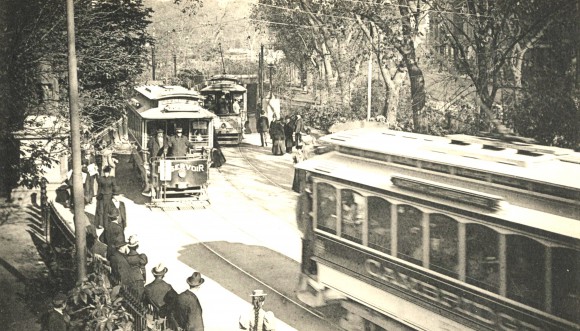Jan. 1, 1889 — Just over a century and a quarter ago, Boston and New York had themselves a choice to make: clean up their respective crowded, stinking, horse-jammed roadways with cable-based transit technology a la San Francisco, soot-belching steam trains like London’s, or go for broke with comparatively untested newfangled electric railways popping up in small experimental models around the country?

New York picked cables. As decisions go, it sort of made sense—cable was cleaner than steam and cheaper than electricity, not to mention wildly overestimated at the time. The Street Railway Journal described it in itsDecember 1899 edition as:
Boston, however, went a very different direction. As Doug Most, author of the 2014 book“The Race Underground” (and a Boston Globe deputy managing editor), explains, this city had one thing New York just didn’t: the bold and patient transit monopolist and head of the West End Street Railway Co., Henry Whitney. In the previous few years, Whitney had almost singlehandedly consolidated Boston’s street transit system under one company and by the late 1880s, was ready to bring modern order to its horse-drawn chaos. He’d looked at the cable option, sure, weighing the efficacy of that model against the narrow, winding Boston streets that would make such a set-up likely more difficult. But then he’d also traveled down to Richmond, Va., to check out a demonstration of an electric street rail by the eager young innovator Frank Sprague. And with that, the choice was made: Boston was to be the first major city to embrace the electric street car, and as Most describes, it happened exactly 126 years ago:
A few minutes after midnight, on January 1, 1889, while bells were ringing out the cold and ringing in the new year, two new electric streetcars quietly pulled out of the Allston railroad depot. There was no crowd to witness the start of the historic journey, the first ride of the West End electric streetcars, and there were no passengers on board other than Henry Whitney himself. They merely drove off into the night, with Frank Sprague manning the controls of one car and one of his electricians driving the other. They had a precise route to follow that Whitney and Sprague had mapped out, from Allston to Park Square downtown, passing through Coolidge Corner in Brookline. The ride was going smoothly, with both the overhead wires and underground conduits working to perfection, until they reached the corner of Boylston and Church streets, where a bad patch of track caused both cars to fall off the rails. But they were quickly returned to the tracks, and by 12: 30 A.M. they had reached Copley Square, where a crowd was still lingering from the new year’s celebration. Whitney, so pleased at how the trip went, told Sprague he wanted to load up both cars with as many passengers as they could fit and drive them up Beacon Street and back , to let them be the first to experience what the future for their city held.
Over the next few years, Boston would go on to electrify nearly all of its street rails, dropping its transportation horse population from 8,000 in 1887 to fewer than 1,000 by 1895. Other cities soon followed suit, and electricity—not cable—grew to dominate the rapid transit scene. In 1897, Boston opened another first, the country’s first subway system, which was blended into a mixed system of subway, street rail, and later, elevated rail. New York City, not that anyone’s counting, didn’t open its subway until 1904.
Whitney’s company faded away replaced by a series of various railway systems and organization over the next century, until the emergence of the MBTA in the 1960s. Today, its legacy might be best described as mixed—pioneering, of course, but also the reliably unreliable system we all know (and love to hate) today.








Leave a Reply
You must be logged in to post a comment.